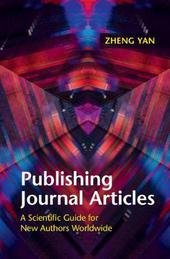
|
Publishing Journal Articles: A Scientific Guide for New Authors Worldwide
Hardback
Main Details
| Title |
Publishing Journal Articles: A Scientific Guide for New Authors Worldwide
|
| Authors and Contributors |
By (author) Zheng Yan
|
| Physical Properties |
| Format:Hardback | | Pages:200 | | Dimensions(mm): Height 160,Width 235 |
|
| ISBN/Barcode |
9781108417341
|
| Classifications | Dewey:808.066378 |
|---|
| Audience | | Professional & Vocational | | Tertiary Education (US: College) | |
|---|
| Illustrations |
Worked examples or Exercises
|
|
Publishing Details |
| Publisher |
Cambridge University Press
|
| Imprint |
Cambridge University Press
|
| Publication Date |
5 November 2020 |
| Publication Country |
United Kingdom
|
Description
Journal publication and grant writing are two core professional skills for new scholars today. However, systematic training is not typically offered in graduate programs worldwide. This book equips readers with the current scientific knowledge by providing a concise introduction to the science of journal article publication. The overall structure generally matches the curriculum of a graduate course and each chapter features a learning sequence based on Daniel Kahneman's intuitive judgement theory. The volume analyzes the intuitive thoughts of new authors from a variety of countries, uses over fifty real-life cases, and focuses on core concepts from nearly 100 research articles. It provides scientific advice for new authors, junior researchers, and graduate students to publish their scholarly work and advance their academic careers.
Author Biography
Zheng Yan graduated from Harvard University Graduate School of Education and is now Associate Professor of Developmental and Educational Psychology at University at Albany. He is also the funding editor-in-chief of Human Behavior and Emerging Technologies. His research focuses on answering the basic question of how modern humans live with emerging technologies.
Reviews'... Yan here applies pedagogical theory to present the requisite knowledge and skills through a 'research-based learning process.' He not only incorporates case studies, examples from various journals, and figures illustrating concepts and processes, but also has tested each chapter through engagement with students. His advice is applicable for graduate students in all disciplines.' M. Herr, Choice
|